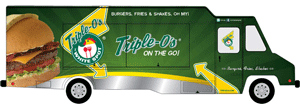QSR research On The Go
Triple O’s is taking its burger-joint fare to the streets with the launch of Canada’s first mobile food truck by a quick-service restaurant (QSR) chain. But that’s not all the food truck will do. In addition to serving its menu items, Triple O’s On The Go will also function as a mobile research and development center to enable the corporate and franchised-based chain to test out new markets and menu items and generate instant guest feedback and sales data.
“Triple O’s On The Go is much more than just a mobile food truck to serve our famous burgers, shakes and fries - it’s a complete R&D facility on wheels,” said Warren Erhart, president of White Spot Limited and Triple O’s. “The mobile restaurant enables us to test out potential new locations and menu items - two of the greatest ‘X-factors’ of any restaurant organization - before putting a stake in the ground. For a prospective franchisee, having this type of firsthand experiential market research is invaluable.”
Some like it furry! The connection between hormones and texture preferences
A woman’s hormonal makeup drives her taste in fabrics and textures, according to findings from DervalResearch, Chicago. Depending upon gender, ethnicity and immune system, individuals have different perceptions of light touch, pressure, pain, cold and vibrations.
Estrogen-driven women prefer animal fabrics such as wool, fur, leather or silk, while their testosterone-driven sisters go for vegetal materials such as cotton and linen. Men, on the other hand, are more sensitive than women to synthetic textiles such as nylon.
Between April 2007 and February 2011, the firm studied 3,500 individuals from 25 different countries. Both men and women of various ethnicities, vocations and general preferences were measured for their individual sensitivity to touch and interviewed about which fabrics they preferred and which ones they found irritating to the touch.
Knowing consumers’ Hormonal Quotient may make it possible to predict not only their favorite textures but also their preferred flavors, smells, shapes and sounds. Diana Derval of DervalResearch suggests that companies may no longer need to conduct recurrent surveys - they only have to identify the profile and HQ of their consumers once.
Kid-innovators seek technology that’s more intuitive
 Kids across the world were asked to draw the answer to this question: What would you like your computer or the Internet to do that it can’t do right now? Latitude, a Beverly, Mass., research company, hoped the question would offer a look into possible futures for technology.
Kids across the world were asked to draw the answer to this question: What would you like your computer or the Internet to do that it can’t do right now? Latitude, a Beverly, Mass., research company, hoped the question would offer a look into possible futures for technology.
More than 200 kid-innovators, ages 12 and under, from Argentina, Australia, Chile, Colombia, Denmark, India, Mexico, The Netherlands, Panama, South Africa, Spain, the U.K. and the U.S., submitted drawings of their imagined technologies. The result? Kids predict that the future of media and technology lies in better integrating digital experiences with real-world places and activities.
The majority of kids (77 percent) imagined technologies with more intuitive modes of input (e.g., verbal, gestural and even telepathic), often capable of human-level responsiveness. One-third of kids invented technologies that would empower them by fostering knowledge or otherwise “adult” skills, such as speaking a different language or learning how to cook.
Several study participants imagined technologies that are just beginning to appear in tech-forward circles, such as Google’s revamped image search, which allows users to place images, rather than text, in Google’s search box to perform a query.
